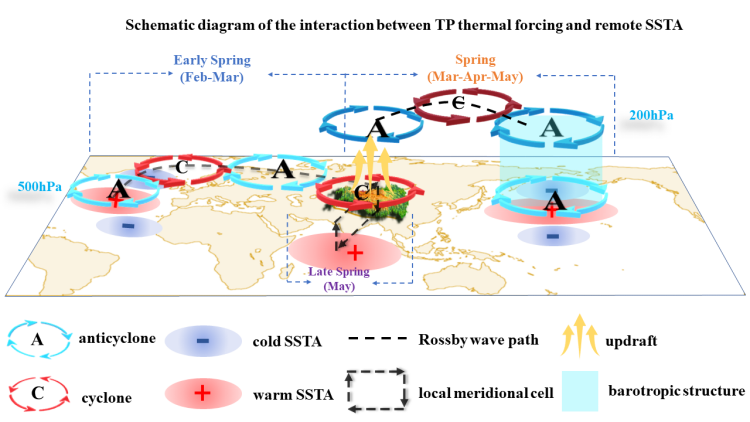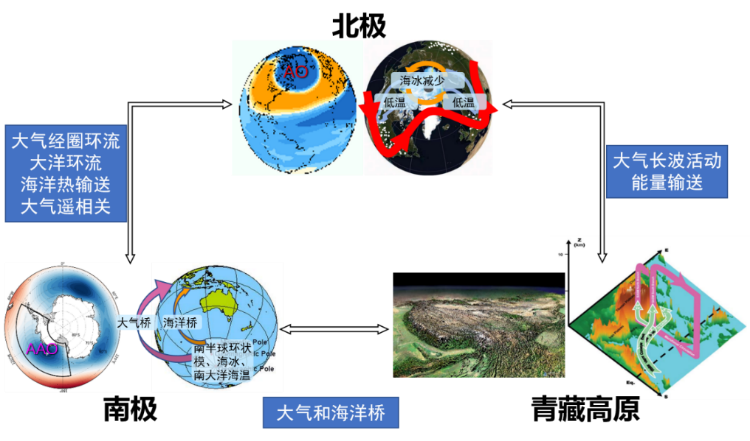Known as the Roof of the World or the Third Pole, the Tibetan Plateau affects over 2 billion people directly by affecting Asian monsoons and providing precious water resources and ecosystem services. In the eyes of climate scientists, it's an excellent and unique natural laboratory. The Tibetan Plateau works like an engine, strengthening the activities of Asian monsoons, which have affected the climate system and topography of Asia.
The climate effect of such a large-scale terrain and Asian monsoons have always been hot research issues in atmospheric sciences. Dr. Duan utilizes his weather forecasting experience and climate dynamics research background along with his research team's skills in modeling and numerical simulations to systematically study how the Tibetan Plateau affects Asian monsoon variability and the characteristics and causes of climate change on the Tibetan Plateau at multiple time scales. They have proposed a conceptual model which shows the interactions between the ocean and plateau during different seasons and their synergistic impacts on East Asian monsoons and climate change (Fig. 1).

Fig. 1 Schematic diagram of the interactions between TP and oceans
Dr. Duan's main interest is to understand the influence of the Tibetan Plateau on the formation of and variation in the Asian monsoon from the perspective of the Earth's climate system and sea-land-atmosphere interaction. His research, mainly utilizing a combination of multi-source data analysis and numerical simulation along with regional and global atmospheric, ocean and air-sea models, focuses on the following questions: (1) Why does the Tibetan Plateau have such an important influence on the formation of the Asian monsoon and its variability at different time scales? (2) What causes the temporal and spatial evolution of surface and atmospheric heat sources (or sinks) on the Tibetan Plateau? (3) Which types of Asian monsoon spatial patterns and temporal variability are directly affected by the Tibetan Plateau? (4) How to consider the synergistic effect of the Tibetan Plateau and large-scale natural air-sea variability, so as to provide useful information for Asian monsoon prediction. (5) What is the specific mechanism of the Earth's tripolar linkage and its connection with the climate of East Asia?
One of Dr. Duan's research projects— examining a coupling linkage among the three poles' climate change on Earth, funded by the NSFC, focuses on the similarities and differences in climate change among the three poles. This project aims to explore the spatial-temporal variation of the air-sea-ice systems in the three poles under historic and future scenarios and to reveal intrinsic physical processes, and then illustrate a physical schematic map about the possible coupling linkage of climate change among them. As the Earth's climate system is a coupled system with multi-layer interactions, the three poles can interact with each other through the meridional atmospheric circulation, the “atmospheric-oceanic bridge,”ocean circulation and ocean heat transport (Fig. 2). In the future, he hopes to find the link among the three poles and explore the mystery of the climate evolution of the Earth's three poles in future.

Fig. 2 Schematic diagram of the interactions among three poles' climate change on Earth
The State Key Laboratory of Marine Environmental Science (MEL) has been encouraging scientists to carry out multi-disciplinary and in-depth research to innovate. As a new member of MEL, Dr. Duan hopes to conduct research with marine biochemists in the future.

Dr. Duan in his office
Dr. Duan received his PhD in climate science in 2003 from the Institute of Atmospheric Physics, Chinese Academy of Sciences. He conducted postdoctoral work at the Graduate Institute of Hydrological and Ocean Sciences at National Central University from 2006 to 2007 and worked at the Institute of Atmospheric Physics from 2006 to 2021. Dr. Duan is a new faculty member in the Department of Physical Oceanography in the College of Ocean and Earth Sciences at Xiamen University (XMU). He joined XMU as a Nanqiang Distinguished Professor and became a member of the State Key Laboratory of Marine Environmental Science (MEL) in October 2021. He is primarily engaged in climate dynamics, Asian monsoons, sea-land-atmosphere interactions, and climate change. He has published over 120 academic papers which have been cited 4600+ times. He is a recipient of the National Science Fund for Distinguished Young Scholars and a “Zhao Jiuzhang Youth Science Award.”.
Dr. Duan has a rich academic background. He is the chief scientist of the State Key Program of the National Natural Science Foundation of China and the International Cooperation Program. He is a distinguished researcher at the International Research Center of Big Data for Sustainable Development Goals (SDG), a member of the Global Energy and Water Exchanges (GEWEX) Project China Committee, a member of the Future Earth China Committee, a member of the American Geophysical Union (AGU) and European Geosciences Union (EGU), and the Executive Director of the China Society on the Tibetan Plateau. He is also an editorial board member of Sustainability, Atmospheric Sciences, and Acta Meteorologica Sinica.
For more information about Dr. Duan, please visit his website https://mel2.xmu.edu.cn/faculty/anminduan/ or contact him at amduan@xmu.edu.cn.